Prophet #28 (Image, $2.99)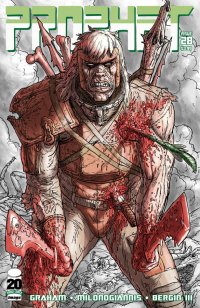
by D.S. Randlett (@dsrandlett)
I have a rather bad habit. When I read comic books month to month, part of the fun for me is trying to pick up on the thematic through line, and try to predict where the plot is going to go from that perception. I tend to be right, but I could probably chalk that up to predictability of the creators I read rather than any depth of perception on my part. The danger of reading like this is that I can get more attached to my own expectations than to the actual pleasures of the book itself. Sometimes it’s fair to confront books on those terms, but other times you end up glossing over you might have otherwise liked. But, it’s an instinct, something that I can’t quite control but need to be aware of.
What makes Brandon Graham and company’s Prophet such an enjoyable reading experience for me is the way that it confounds that instinct. Getting into this series is certainly an adjustment, as it makes absolutely no attempt to meet you halfway. It demands that you take it on its own terms in every aspect, and in a field filled with properties looking for a film development deal, that’s something refreshing. It’s something to be celebrated.
The way Graham writes this story has the character of a weird sort of dream. The narrative flow jumps from one scene to the next, but at the same time as a sort of languid feel. I’ve only ever experienced that sort of movement in my sleep, and now while reading Prophet. And it’s a damn weird dream. It has the character of something like Jodorowsky’s Metabarons, the fiction of Jack London, and the films of Miyazaki. Whereas last week’s Spaceman posited a future that seems entirely plausible based on current culture and politics, Prophet posits a future that I’m surprised that anyone has been able to imagine. It’s a future where the only homo sapiens still living are all clones of the same man, the warrior Jonathan Prophet, who seek to fulfill the will of the head of the Earth Empire, which appears to be an artificial intelligence of some sort. The universe has been taken over by other bizarre (but intelligent) forms of life, though, and it is them that the Earth Empire, which has nothing living at its core, seeks to dominate. Arrayed against these forces is the “old man” Prophet, apparently the father of the Prophets who are doing the Earth Empire’s bidding. This vision seems to postulate that our inventions will outlive us, and continue to perform barbarities against things that still yet live. As a view of human nature, it makes my blood run cold.
But that is part of what makes Prophet so good. It seeks to challenge on every level, from the thematic to the aesthetic. It achieves these aims without ever sacrificing readability or clarity. Sometimes you need to remember why you read comic books. Prophet is one such reminder.
Rating: 




Out of a Possible 5 Stars
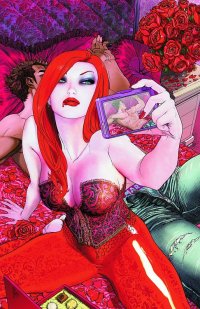 National Comics: Looker #1 (DC Comics, $2.99)
National Comics: Looker #1 (DC Comics, $2.99)
By Devon Sanders
I don’t know WHAT the fuck I’ve just read.
Is it a pilot? Is it satire? (pause)
I don’t know what the FUCK I’ve just read.
I mean I’m familiar with Looker. I remember her from Batman and The Outsiders. She used to be a member. She was a mousy bank teller who was something like a chosen one from a lost underground civilization who prophesied that one the day Haley’s Comet passed overheard, she’d get superpowers and become beautiful.
THAT I got… somehow.
THIS. I don’t know what THE fuck I’ve just read.
This thing written by Ian Edgington and drawn by Mike S. Miller is just gloriously mindbogglingly bad.
Looker, a former fashion model, wakes up in a garbage dump; left for dead after a one-night stand with a vampire goes wrong. She turns and since a supermodel doesn’t show up on camera anymore, she opens a modeling agency.
…the fuck?!?
Um… she constantly talks about couture while engaging in inner monologue about cocaine addicted models while taking down vampires. May I mention she’s in love with a blind cop/sculptor who loves her in return because, you know, even though he can’t SEE her, he can see her heart?
Of course.
May I mention she has a gay guy who mothers her?
And the art! The art is just insanely 90’s! It’s all poses!
I don’t know if this was intended as some sort of parody of 90’s tv action shows but this fucking thing ends with a supermodel/vampire, a gay “mother” and a naïf wanna-be supermodel personal assistant sitting on a leather couch smiling triumphantly while clinking together champagne glass.
On the final panel, I could honestly hear a 90’s sax solo while reading this thing!
If this comic was conceived as a sincere, serious thing…?
I don’t know. Should I applaud the hubris?
I do not know what the fuck I’ve just read but…
It was horrible.
I really enjoyed it.
Rating: 




Out of a Possible 5 Stars
Captain Marvel #1-3 (Marvel, $2.99)
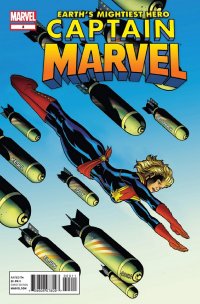
By Adam Prosser
At the risk of immediately turning this into a pointlessly contentious and self-absorbed review, I’m a feminist. I don’t think there’s much to this, really: you believe women should be treated the same as men? Boom, you’re a feminist. There shouldn’t be a huge stigma about it, and it doesn’t need to have all kinds of attention called to it either; it’s just that in our polarized culture we can seemingly no longer have an opinion without trying to scream it louder than the other guy.
I bring this up because superhero comics’ relationship with the female gender has been rocky from the beginning. There’s always been an assumption that the genre leans more towards male readers (usually kids or teenagers, or, these days, those with the same level of mental sophistication) and as a result it’s often skewed away from portraying women as human beings and more as mysterious, unapproachable figures of power, whether sexual or intimidating or intimidatingly sexual. When comics DO try to portray the dreaded “strong female characters”, it often comes off as apathetic tokenism, smirking sarcasm, or just plain weirdness. The most common result, assuming the writer has his (and yes, until recently, we’re almost certainly talking about “his”) heart in the right place, is the obnoxious stereotype of the Ultrabadass Woman Who Doesn’t Let Any Man Tell Her What To Do, and who demonstrates it by picking fights with conveniently-provided male chauvinists. Or maybe a rapist or two! Nothing says “empowered female” like seeing a woman beat up a couple of rapists, right? Granted, this is egalitarian in a way—comics culture is often coming from a place of extreme unselfconfidence and tends to resort to knee-jerk pissing contests to “prove” how awesome they are, such as the by-now clichéd scenes where the writer’s favourite character is able to beat everyone else up. But of course this tends to leave the impression that the subject in question actually isn’t all that great, and that they’re overcompensating; you rarely see Superman’s strength and power being touted, because nobody needs to do so. So when female superhero characters are depicted as pugnacious badasses, well, again, the word “overcompensating” comes to mind.
And yet some characters DO overcompensate, and with the new Captain Marvel series, writer Kelly Sue DeConnick shows how you can take the kinds of elements that have been so badly handled by people trying to write superheroines in the past, and makes them work. Carol Danvers is a fighter pilot and a former alcoholic (as well as having gone through some pretty squicky stuff back in the day, a fate sadly common to superheroines) so it actually makes sense that she’d be a somewhat belligerent hotshot with something to prove, but DeConnick manages to write the character with a level of fun and charisma which is often the missing element in these kinds of stories. Of course, the anachronistic, skimpily-clad gang of WWII-era women soldiers might be a little much…
Perhaps I should back up.
The new series starts with Carol adopting a new costume and, with some reticence, the alias of her former mentor Mar-Vell after Captain America encourages her to do so. (“Captain America said it was OK” is another one of those potentially overcompensating clichés in the Marvel U, but again, it’s handled well here.) She then grapples with the idea that her superpowers have taken away from her accomplishments as a pilot, and decides to prove herself by repeating a flight taken by another female pilot back in the day, in order to prove that it was possible. Just as you’re wondering if this story has forgotten that it’s about superheroes, Marvel finds herself thrown back in time to the Pacific theatre in WWII, where she meets the aforementioned all-girl Banshee Squad, and discovers that the Japanese are using Kree technology (the same alien race from which her powers derive).
DeConnick is actually so good at writing naturalistic characters, and keeps things so low-key for the first issue and a half, that it’s actually a little bit jarring when the crazy comic book stuff shows up. The theme DeConnick’s tackling here (and I hate to make it sound like only a woman can write this kind of stuff intelligently, but let’s say that most male superhero writers have demonstrated that they may be somewhat in the dark when it comes to this stuff) is the often-overlooked contributions women have made to history. In comic book terms, that translates to a bunch of sexy riot grrrlz fighting Japanese spaceships.
Dexter Soy’s artwork is…an acquired taste. I’m not actually a big fan of the painterly, supposedly “realistic” style we see in a lot of superhero books these days, but Soy abstracts it to a level that actually helps make the story flow better and keeps things in a heightened reality. While I actually wish things were a little more packed and zany—issue 2 ends with a great moment that probably should have been the end of issue one—it’s a solid series so far. Not, perhaps, the amazing success that we’d like to see from a female superhero who bears the company’s name, but a respectable effort.
Rating: 




Out of a Possible 5 Stars
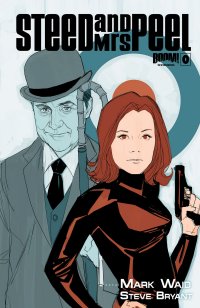 Steed and Mrs. Peel #0 (Boom!, $2.99)
Steed and Mrs. Peel #0 (Boom!, $2.99)
By Jeb D.
The recent reissue of Eclipse’s early-90’s Steed and Mrs. Peel title, highlighted by the work of a (relatively) young Grant Morrison, seems to have done well enough for Boom! to launch a new ongoing, but one has to wonder how much of its performance had to do with interest in Morrison’s formative years: it’s not hard to picture The Avengers‘ wicked humor and straight-faced embracing of the weird having an influence on a writer on the verge of things like The Invisibles, and as a work-for-hire project, Morrison acquitted himself well, using the multi-issue format to tell a story that hewed to the traditions of the TV series, while still allowing it to breathe. But, of course, it was still subject to the hemmed-in boundaries of the licensed property: not only are these someone else’s toys, but unlike, say, Spider-Man or Batman, the publisher is only renting them for some period of time, and they have to be left intact for the next licensee, leaving even less room for creativity.
And while it’s interesting to look back at the young Morrison having his fun with Steed, Emma, and Tara King, it’s a bit different when a project like this falls into the hands of a veteran writer like Mark Waid, currently flavor of the month with the Eisner win for his current excellent run on Daredevil (and high expectations for his new Marvel Now! Hulk title). While he’s no longer EIC of Boom! Comics, and has wrapped up his creator-owned Irredeemable and Incorruptible, he’s keeping his hand in on work outside the Big 2. Given both his track record, and his continued vitality as a creator, though, it is a bit disappointing to see him adding to the current flood of reworkings of licensed properties, even one as dear to my heart as TV’s original Avengers.
In a way, of course, this dovetails with his recently-launched Rocketeer series, but there’s a key difference: Dave Stevens’ Rocketeer was always an episodic story, published over several years in a shifting variety of formats, and built around classic adventure-story tropes. The Avengers was not only a show of quirks and idiosyncracies, but as the product of an age of television before cable, satellite, and the Internet, its structure was consistent to the point of being rigid and repetitive. The notion of ongoing throughline or story arcs was an unfamiliar one to TV watchers of the 60’s; particularly with the big money in TV being in eventual sales to local and regional syndication, storylines needed to be kept tidy and self-contained, allowing viewers to drop in and out at will, with nothing resembling the continuity that modern audiences take for granted in ongoing TV (or comic book) series (one of the most popular TV series of the day, The Fugitive, fared very poorly in syndication due to the decision to actually provide an ending to Richard Kimble’s quest for the real murderer of his wife). And for better or worse, Waid expertly captures the familiar pacing and beats we associate with a typical episode of The Avengers (absent, of course, the snappy harpsichord chase music). His Steed and Mrs. Peel sound very much like their TV counterparts, the villain’s scheme has a vintage 60’s sci-fi feel to it, and Steed’s foiling of it is appropriately absurd and unlikely. Boom’s decision to “educate” X-Men fans that Chris Claremont’s Hellfire Club was inspired by an Avengers episode feels like a bit of heavy-handed inside baseball, though.
Though its early incarnation was fairly low-budget and drab-looking, by the time The Avengers got to American viewers, it was a visually-arresting TV series, even in its black and white iteration, so the best hope for this series rising above the curiosity factor would be similarly visually-arresting art, but that’s sadly not the case. Ian Gibson’s work on the Morrison series wasn’t particularly to my taste, but I could see its strength and consistency; it captured a mood of disquiet that fit the story pretty well, even if it didn’t fit my memories of the TV series. Steve Bryant, on the other hand, while trying to capture the look of a ’67-era Avengers episode, sacrifices character and consistency (from page to page, he seems to be deciding whether or not to actually base Steed and Emma on Macnee and Rigg), while his action scenes are stiff and unconvincing. I found some of the same qualities lacking in his work on Athena Voltaire, but he seemed to make up for some of that with a depth and richness that’s missing in this issue; I don’t recall if Bryant used an inker on that series, but that might have helped here (I have no idea if there were any deadline problems with this comic, but it wouldn’t surprise me to learn it was a bit of a rush job for Bryant).
Given that this is an introductory “#0 issue,” it’s possible that Waid’s future plans for the series will involve more than just cleverly riffing on past memories of the TV series; but absent the living, breathing chemistry of Macnee and Rigg, and the immediacy of the production values, music, and photography of the original, it’s hard to see this being anything more than a nostalgic nod to the past.
Rating: 




Out of a Possible 5 Stars
Green Lantern Annual #1 & Justice League #12 (DC, $4.99 & $3.99)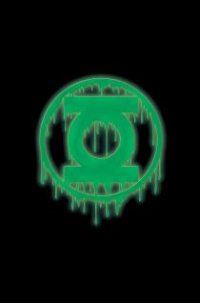
by D.S. Randlett (@dsrandlett)
This month, you have all the proof you need that The New 52… thing wasn’t planned all that far in advance.
We’re nearing the end of Geoff Johns’ highly successful run on Green Lantern, which has actually been rather fun over the long haul. This Green Lantern Annual, which wraps up a brief Black Hand story and launches the GL franchise into one of its big events, The Rise of the Third Army, is a pretty decent superhero book. We see some things that Johns has been teasing for a couple of years now, like the not yet fully revealed First Lantern. There’s a lot going on, with new elements of the GL mythos being revealed. Johns hasn’t lost step with what has made his GL run worth following: it’s fucking crazy. There are zombies. There’s body horror. And of course, superheroes. Green Lantern, over the past few years, has hit places like this, where all of these different genres come together in a way that really shouldn’t work. But it does.
All in all, Green Lantern is still what it’s been for some time now: a solid meat and potatoes superhero book that displays a lot of imagination. What’s interesting is that some of the stuff that’s starting to pay off was teased by Johns well over a year ago. I remember watching the commentary on the GL: Emerald Knights DTV movie and hearing him tease the First Lantern character and talking about how the Guardians aren’t what they seem. He’s still playing his long game, and it shows in the writing. It isn’t the best in the world, but it has clear goals, momentum, and themes.
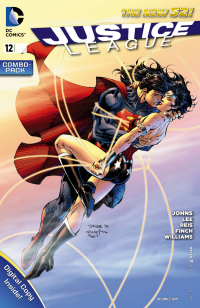 Justice League doesn’t. I’ve been reading it for the past year in the same way that I’ve been reading Superman, with a sort of morbid fascination about what the book is saying about its publisher. For all of his faults, I think that Johns has a genuine gift for finding his way into a character and starting there. His biggest fault, however, is that he really seems to subscribe to a certain take on “the way things are supposed to be.” These two creative instincts clash in everything he does, and in some of his work in creates a genuinely interesting narrative friction. But with time, the second impulse eventually wins. His work with The Flash is evidence enough of that, with the Flash family’s restoration to the Silver Age status quo more or less after 40 damn years. Justice League has been “the second Johns” right from the get go.
Justice League doesn’t. I’ve been reading it for the past year in the same way that I’ve been reading Superman, with a sort of morbid fascination about what the book is saying about its publisher. For all of his faults, I think that Johns has a genuine gift for finding his way into a character and starting there. His biggest fault, however, is that he really seems to subscribe to a certain take on “the way things are supposed to be.” These two creative instincts clash in everything he does, and in some of his work in creates a genuinely interesting narrative friction. But with time, the second impulse eventually wins. His work with The Flash is evidence enough of that, with the Flash family’s restoration to the Silver Age status quo more or less after 40 damn years. Justice League has been “the second Johns” right from the get go.
In a way, we’re hearing some of the greatest hits, but played without verve or energy. In the first arc, we had the League meeting to face Darkseid, but there was no story there. Just banter, action, and a waste of great characters. After that, we had an arc that basically reprised Johns’ take on Professor Zoom. David Graves, who actually sported a rather creepy and cool design courtesy of Jim Lee, was (is? I suppose there’s nothing precluding him from popping up again) a villain who wants to make our heroes “better.” But what does that really mean? The end of the twelfth issue of the series says that the members of the Justice League learned a lesson here, that they’re really flawed human beings after all, and not gods. But we’ve never seen them think of themselves as gods, there’s no reason that they need a reminder.
That’s the problem with Justice League in a nutshell, and it’s further illustrated by Superman and Wonder Woman’s kiss. Much has been said about this relationship over the past couple of weeks in the comics sphere. Really, I have no problem with it as an idea, or the idea that this iteration of Superman can date around a bit (there are stories there, after all) before setting his sights on Lois Lane, or any of that. The problem that I have with it is context. It comes out of nowhere, just like pretty much every single moment in Justice League. It puts the lie to the idea of a “grand plan,” that’s in place. We’re swimming in a sea of half baked ideas predicated on a certain vision of what DC Comics “should” be, and narrative comes second to fulfilling the dictates of that “should.” It stinks.
Green Lantern Annual #1
Rating: 




Out of a Possible 5 Stars
Justice League #12
Rating: 




Out of a Possible 5 Stars